|
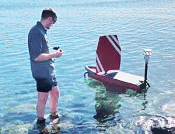 "The boats, just over a meter long and called
C-Stars, will gather meteorological and oceanographic data for hurricane research
and forecasting. 'Understanding weather conditions where the ocean surface meets
the lower atmosphere is key to predicting hurricane intensity,' said NOAA oceanographer
Greg Foltz. 'If these
miniature uncrewed surface vehicles prove reliable, they could become a critical
piece of NOAA's hurricane observing system in the future.' The five C-Stars were
set loose off the island of St Thomas in the British Virgins Islands, and are receiving
instructions from NOAA and the University of Southern Mississippi via Oshen's..." "The boats, just over a meter long and called
C-Stars, will gather meteorological and oceanographic data for hurricane research
and forecasting. 'Understanding weather conditions where the ocean surface meets
the lower atmosphere is key to predicting hurricane intensity,' said NOAA oceanographer
Greg Foltz. 'If these
miniature uncrewed surface vehicles prove reliable, they could become a critical
piece of NOAA's hurricane observing system in the future.' The five C-Stars were
set loose off the island of St Thomas in the British Virgins Islands, and are receiving
instructions from NOAA and the University of Southern Mississippi via Oshen's..."
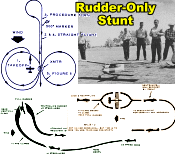 Not all that long ago, my interpretation
of radio-controlled (R/C)
rudder-only
(RO) flying was that the airplane operated from a single channel controlling the
rudder. That is the way it began, I suppose, but as aerobatic competition entered
the picture, it expanded to include throttle control on the engine. Some models,
I believe might have also had elevators and/or aileron control, but during competition
flights, only the engine throttle and rudder were allowed to be manipulated. I have
flown many R/C airplanes with just two channels - rudder and elevator - but never
with rudder and engine throttle. In fact, the only airplane I have ever flown with
only rudder control is an experimental rubber-powered job with an electromagnet
coil and a permanent magnet on the rudder. Many magazine articles... Not all that long ago, my interpretation
of radio-controlled (R/C)
rudder-only
(RO) flying was that the airplane operated from a single channel controlling the
rudder. That is the way it began, I suppose, but as aerobatic competition entered
the picture, it expanded to include throttle control on the engine. Some models,
I believe might have also had elevators and/or aileron control, but during competition
flights, only the engine throttle and rudder were allowed to be manipulated. I have
flown many R/C airplanes with just two channels - rudder and elevator - but never
with rudder and engine throttle. In fact, the only airplane I have ever flown with
only rudder control is an experimental rubber-powered job with an electromagnet
coil and a permanent magnet on the rudder. Many magazine articles...
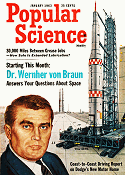 Former
Nazi Germany's famed rocket scientist
Dr. Wernher von Braun's 1963 Popular Science magazine column answers
questions submitted by reader representing the overwhelming public interest in space
science, which motivated his monthly contributions to share complex topics accessibly.
He explains that steering large rockets involves deflecting exhaust thrust via swiveling
nozzles or jet vanes, contrasting liquid and solid propellant methods. Astronauts
exit pressurized cabins using airlocks, depressurizing the compartment before venturing
into space. Liquid hydrogen's efficiency as fuel stems from its high energy release
and low molecular weight, yielding superior exhaust velocity. Von Braun also touches
on the moon's likely sterility, solar flares' hazards to manned missions, and the
sun’s volatile activity, emphasizing space science’s interdisciplinary and dynamic
nature. This is the first of two articles submitted... Former
Nazi Germany's famed rocket scientist
Dr. Wernher von Braun's 1963 Popular Science magazine column answers
questions submitted by reader representing the overwhelming public interest in space
science, which motivated his monthly contributions to share complex topics accessibly.
He explains that steering large rockets involves deflecting exhaust thrust via swiveling
nozzles or jet vanes, contrasting liquid and solid propellant methods. Astronauts
exit pressurized cabins using airlocks, depressurizing the compartment before venturing
into space. Liquid hydrogen's efficiency as fuel stems from its high energy release
and low molecular weight, yielding superior exhaust velocity. Von Braun also touches
on the moon's likely sterility, solar flares' hazards to manned missions, and the
sun’s volatile activity, emphasizing space science’s interdisciplinary and dynamic
nature. This is the first of two articles submitted...
 Aircraft historians might find the information
from this 1942 edition of Flying Aces magazine useful. As has long been
the case on many Russian airplanes and helicopters, the basic outlines - and often
even the details - are recognizable from the original versions designed by the United
States, England, and Germany. The Russkies have been short on design and test capabilities
and long on materials, manpower, and espionage agents. It wouldn't be so bad if
the copying was not so obvious. Even their attempt at a space shuttle was a carbon
copy of ours. If not for their leaders' commitment to Communism and Socialism, Russia
could be... Aircraft historians might find the information
from this 1942 edition of Flying Aces magazine useful. As has long been
the case on many Russian airplanes and helicopters, the basic outlines - and often
even the details - are recognizable from the original versions designed by the United
States, England, and Germany. The Russkies have been short on design and test capabilities
and long on materials, manpower, and espionage agents. It wouldn't be so bad if
the copying was not so obvious. Even their attempt at a space shuttle was a carbon
copy of ours. If not for their leaders' commitment to Communism and Socialism, Russia
could be...
 My daughter and her husband bought an 11-acre
chunk of a small, retired dairy farm in North Carolina a few years ago. Their property
included all of the original buildings, including the house, a large workshop, farm
equipment shed row, milking stalls, milk processing area, hay storage, a chicken
house, and a few other structures. Nearly everything is at least 50 years old -
and it shows. There are two active
wells on the property - one next to the house, and another in a field next to
a utility building. They are independent, but there is a pipe connecting the two
systems, with a valve in between to isolate them if necessary. The photo/drawing
to the right shows, schematically, what we believe, based on testing, to be the
water line layout. The valve was originally open, and then one day there was no
water service. With two pumps in parallel, if one pump fails the other will supply
sufficient water for all needs in what is now a domestic setting... My daughter and her husband bought an 11-acre
chunk of a small, retired dairy farm in North Carolina a few years ago. Their property
included all of the original buildings, including the house, a large workshop, farm
equipment shed row, milking stalls, milk processing area, hay storage, a chicken
house, and a few other structures. Nearly everything is at least 50 years old -
and it shows. There are two active
wells on the property - one next to the house, and another in a field next to
a utility building. They are independent, but there is a pipe connecting the two
systems, with a valve in between to isolate them if necessary. The photo/drawing
to the right shows, schematically, what we believe, based on testing, to be the
water line layout. The valve was originally open, and then one day there was no
water service. With two pumps in parallel, if one pump fails the other will supply
sufficient water for all needs in what is now a domestic setting...
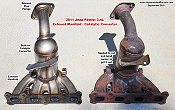 I have the great misfortune of being a 2011
Jeep Patriot owner with the
welded steel
combination exhaust manifold and catalytic converter that forms heat stress cracks,
resulting in loud noise levels in the passenger cabin. Whilst out driving one day
recently, I noticed the sound level increased significantly, but not at all speeds.
After a lot of testing and researching on the Internet, I concluded it had to be
either a bad muffler, a loose baffle in the catalytic converter, or a crack in the
exhaust manifold. It sure sounded like it was coming from the engine area, but I
figured at 102,000 miles, it wouldn't hurt to try replacing the muffler first. No
such luck. I had a new muffler and the same old noise. Upon removing the upper heat
shield from the exhaust manifold, I could immediately see two crack lines in the
steel... I have the great misfortune of being a 2011
Jeep Patriot owner with the
welded steel
combination exhaust manifold and catalytic converter that forms heat stress cracks,
resulting in loud noise levels in the passenger cabin. Whilst out driving one day
recently, I noticed the sound level increased significantly, but not at all speeds.
After a lot of testing and researching on the Internet, I concluded it had to be
either a bad muffler, a loose baffle in the catalytic converter, or a crack in the
exhaust manifold. It sure sounded like it was coming from the engine area, but I
figured at 102,000 miles, it wouldn't hurt to try replacing the muffler first. No
such luck. I had a new muffler and the same old noise. Upon removing the upper heat
shield from the exhaust manifold, I could immediately see two crack lines in the
steel...
 A couple years ago I posted an article about
the Victor Stanzel ElectroMic "Copter" Tethered Helicopter that I had bought on
eBay. It was just like the one I had as a pre-teen in the 1960's. If memory serves
me correctly, I also had one of the ElectroMic Flash Tethered Airplanes as well.
Someday I'll probably buy one of those on eBay. The webpage hyperlinked above has
a video embedded that tells the story of the
Stanzel Brothers' Model Airplane Museum. You will be amazed at
all the types of models they produced - powered airplanes, gliders, helicopters,
flying saucers. They were a couple of the earliest pioneers in manufacturing ready... A couple years ago I posted an article about
the Victor Stanzel ElectroMic "Copter" Tethered Helicopter that I had bought on
eBay. It was just like the one I had as a pre-teen in the 1960's. If memory serves
me correctly, I also had one of the ElectroMic Flash Tethered Airplanes as well.
Someday I'll probably buy one of those on eBay. The webpage hyperlinked above has
a video embedded that tells the story of the
Stanzel Brothers' Model Airplane Museum. You will be amazed at
all the types of models they produced - powered airplanes, gliders, helicopters,
flying saucers. They were a couple of the earliest pioneers in manufacturing ready...
 While perusing the local Goodwill store,
Melanie and I happened upon this old
gooseneck lamp.
Unlike most of the newer models found in places like Walmart, this one is made of
heavy stamped steel, and the gooseneck part is very sturdy with no plastic. When
you bend this lamp into position, it stays exactly where you put it without reflexing
back a little. It was just what Melanie needed for use on her sewing table, so we
bought it as a fixer-upper. As can be seen in the photos, the original condition
was useable, but not... While perusing the local Goodwill store,
Melanie and I happened upon this old
gooseneck lamp.
Unlike most of the newer models found in places like Walmart, this one is made of
heavy stamped steel, and the gooseneck part is very sturdy with no plastic. When
you bend this lamp into position, it stays exactly where you put it without reflexing
back a little. It was just what Melanie needed for use on her sewing table, so we
bought it as a fixer-upper. As can be seen in the photos, the original condition
was useable, but not...
 Our one-car garage does not have a lot of
extra space in it, especially considering it also holds a riding lawn mower, a snow
blower, a backup power generator, and various and sundry yard and car tools. That
doesn't leave much room for the assortment of shoes and boots needed by Melanie
and me. We had been using a stack of cinder
blocks to stuff shoes in, but they looked rather crude and the holes were not
really big enough to allow the shoes to be fully enclosed. After completing building
a set of stairs into the basement, there were end pieces of the stair treads left
over that were just the right width to fit into the space where the cinder blocks
used to be stacked. 2x3 framing lumber... Our one-car garage does not have a lot of
extra space in it, especially considering it also holds a riding lawn mower, a snow
blower, a backup power generator, and various and sundry yard and car tools. That
doesn't leave much room for the assortment of shoes and boots needed by Melanie
and me. We had been using a stack of cinder
blocks to stuff shoes in, but they looked rather crude and the holes were not
really big enough to allow the shoes to be fully enclosed. After completing building
a set of stairs into the basement, there were end pieces of the stair treads left
over that were just the right width to fit into the space where the cinder blocks
used to be stacked. 2x3 framing lumber...
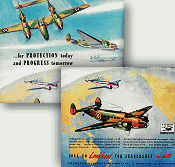 During World War II, many companies
who manufactured products for the military bought advertising space in popular household
magazines such as The Saturday Evening Post, Ladies' Home Journal,
Popular Mechanics, Better Homes & Gardens, Good Housekeeping,
and, as shown here Life. In this instance,
Lockheed Aircraft Corporation
(before merging with Martin Aircraft in 1995) ran a two-pager in 1942, near the
beginning of official U.S. involvement following the Japanese bombing of Pearl Harbor,
featuring its line of both commercial and military aircraft. The U.S. government
commandeered many companies' manufacturing facilities to mandate conversion to wartime
products. It happened across a wide swath of industries including aircraft, automotive... During World War II, many companies
who manufactured products for the military bought advertising space in popular household
magazines such as The Saturday Evening Post, Ladies' Home Journal,
Popular Mechanics, Better Homes & Gardens, Good Housekeeping,
and, as shown here Life. In this instance,
Lockheed Aircraft Corporation
(before merging with Martin Aircraft in 1995) ran a two-pager in 1942, near the
beginning of official U.S. involvement following the Japanese bombing of Pearl Harbor,
featuring its line of both commercial and military aircraft. The U.S. government
commandeered many companies' manufacturing facilities to mandate conversion to wartime
products. It happened across a wide swath of industries including aircraft, automotive...
 Prior to the widespread use of mufflers
on radio controlled model aircraft engines,
exhaust dampers were installed that worked in unison with the
throttle. They were oblong or butterfly-shaped flat pieces of metal that pivoted
in the center and were connected via a short pushrod to the carburetor's throttle
arm. At full throttle, the damper was straight up and down to block the exhaust
port as little as possible. At idle, the damper usually totally blocked off the
exhaust port; of course some exhaust was still able to exit or the engine would
choke out and stop running. The first R/C engines I used in the 1970's came with
exhaust dampers... Prior to the widespread use of mufflers
on radio controlled model aircraft engines,
exhaust dampers were installed that worked in unison with the
throttle. They were oblong or butterfly-shaped flat pieces of metal that pivoted
in the center and were connected via a short pushrod to the carburetor's throttle
arm. At full throttle, the damper was straight up and down to block the exhaust
port as little as possible. At idle, the damper usually totally blocked off the
exhaust port; of course some exhaust was still able to exit or the engine would
choke out and stop running. The first R/C engines I used in the 1970's came with
exhaust dampers...
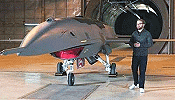 "Anduril Industries recently unveiled its
collaborative combat aircraft, or CCA, when CEO and co-founder Brian Schimpf took
a journalist into the hangar to show off the company's new
Fury, an unmanned autonomous CCA. It was the first time any media outlet was
permitted to view the aircraft up close. As a CCA, the Fury is designed to work
in coordination with manned aircraft. Anduril developed the Fury to sense and understand
everything that is happening in the airspace, and as it flies out ahead of a manned
aircraft, its job is to react to protect the pilot flying in trail. Schimpf said,
'The first thing you notice about this plane is that there's no cockpit. There is
no seat. There's no controls..." "Anduril Industries recently unveiled its
collaborative combat aircraft, or CCA, when CEO and co-founder Brian Schimpf took
a journalist into the hangar to show off the company's new
Fury, an unmanned autonomous CCA. It was the first time any media outlet was
permitted to view the aircraft up close. As a CCA, the Fury is designed to work
in coordination with manned aircraft. Anduril developed the Fury to sense and understand
everything that is happening in the airspace, and as it flies out ahead of a manned
aircraft, its job is to react to protect the pilot flying in trail. Schimpf said,
'The first thing you notice about this plane is that there's no cockpit. There is
no seat. There's no controls..."
 After just 33 years, this crewel picture
that Melanie stitched is complete and has a
custom frame. If
memory serves correctly, we bought the crewel kit at a Ben Franklin store in Severna
Park, Maryland, in 1985 while living in Arnold, Maryland. She started it shortly
after getting it, and then it was put away until last year, 2017, when she decided
to complete the project. Most, if not all, of the needlework pictures Melanie has
done over the years have been placed in custom frames made by me. I've used pine,
oak, teak, hickory, mahogany, and now maple for this frame. The maple wood... After just 33 years, this crewel picture
that Melanie stitched is complete and has a
custom frame. If
memory serves correctly, we bought the crewel kit at a Ben Franklin store in Severna
Park, Maryland, in 1985 while living in Arnold, Maryland. She started it shortly
after getting it, and then it was put away until last year, 2017, when she decided
to complete the project. Most, if not all, of the needlework pictures Melanie has
done over the years have been placed in custom frames made by me. I've used pine,
oak, teak, hickory, mahogany, and now maple for this frame. The maple wood...
 Per this 1962 Popular Science magazine
article, while awaiting Mariner 2's historic sweep past the cloud-shrouded planet
of Venus, experts of imagined Earth's nearest neighbor alternately as a lush prehistoric
swamp-world, a dust-choked desert, an endless steamy ocean, or a tar-lake Hades
reeking with oily smog. What they knew for sure: Venus, a near-twin to Earth in
size and gravity, shows only a bright, lemon-yellow veil when viewed through telescopes.
Spectrograms pushed earlier revealed thick carbon-dioxide and a wisp of water vapor,
but no firm answers about rotation speed or surface material. Then came shocking
new microwave temperature data -600 °F surface heat, day and night. It would be
1975 until the USSR's Venera 9 spacecraft landed on the surface and radioed
back the first images... Per this 1962 Popular Science magazine
article, while awaiting Mariner 2's historic sweep past the cloud-shrouded planet
of Venus, experts of imagined Earth's nearest neighbor alternately as a lush prehistoric
swamp-world, a dust-choked desert, an endless steamy ocean, or a tar-lake Hades
reeking with oily smog. What they knew for sure: Venus, a near-twin to Earth in
size and gravity, shows only a bright, lemon-yellow veil when viewed through telescopes.
Spectrograms pushed earlier revealed thick carbon-dioxide and a wisp of water vapor,
but no firm answers about rotation speed or surface material. Then came shocking
new microwave temperature data -600 °F surface heat, day and night. It would be
1975 until the USSR's Venera 9 spacecraft landed on the surface and radioed
back the first images...

This particular
Hobby People advertisement is from page 53 of the March 1970 issue
of American Aircraft Modeler magazine. Hobby People was probably the first
company that I ever did mail order from to get airplane supplies. Hobby People is
no longer in operation. All copyrights (if any) are hereby acknowledged. Use the
U.S. Bureau of Labor Statistics' inflation calculator to see what items cost in
today's dollars. For instance, that $3.99 "Cox .049 Babe Bee" engine would be $26.16
in 2018 money. The "regular" price of $6.00 would be $39.34 in 2018. Cox International.
Use the U.S. Bureau of Labor Statistics' inflation calculator to see what items
cost in today's dollars. For instance, that $3.99 "Cox .049 Babe Bee" engine would
be $34.05 in 2025 money...
 One of the first woodworking projects I
remember doing after Melanie and I were married and in our own house was making
a paper towel
holder out of some scrap pieces of oak flooring. The wood was in the basement
of the house, probably from when it was originally installed sometime in the 1950s.
A few pieces were glued together along their tongue and groove edges, and then scraped
and sanded to a smooth, flat surface. The bottom curved relief shape was retained
for character. At some point during our many household moves, the paper towel holder
disappeared - we probably donated it as with... One of the first woodworking projects I
remember doing after Melanie and I were married and in our own house was making
a paper towel
holder out of some scrap pieces of oak flooring. The wood was in the basement
of the house, probably from when it was originally installed sometime in the 1950s.
A few pieces were glued together along their tongue and groove edges, and then scraped
and sanded to a smooth, flat surface. The bottom curved relief shape was retained
for character. At some point during our many household moves, the paper towel holder
disappeared - we probably donated it as with...
 "From a [maple] seed-inspired design to a
26-minute flight time on a single rotor, a new
monocopter developed by SUTD researchers marks a 10-year journey towards redefining
how efficient small flying robots can be. When Singapore celebrated its 50th year
of independence in 2015, a team of student researchers led by Associate Professor
Foong Shaohui from Singapore University Technology and Design (SUTD) embarked on
an ambitious challenge: to design and build a drone capable of 50 minutes of sustained
flight. At the time, most hobbyist quadcopters could barely manage half of that.
The SG50 Multi-Rotor Drone..." "From a [maple] seed-inspired design to a
26-minute flight time on a single rotor, a new
monocopter developed by SUTD researchers marks a 10-year journey towards redefining
how efficient small flying robots can be. When Singapore celebrated its 50th year
of independence in 2015, a team of student researchers led by Associate Professor
Foong Shaohui from Singapore University Technology and Design (SUTD) embarked on
an ambitious challenge: to design and build a drone capable of 50 minutes of sustained
flight. At the time, most hobbyist quadcopters could barely manage half of that.
The SG50 Multi-Rotor Drone..."
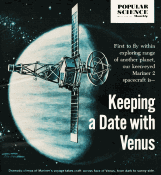 At launch in 1962 when this article appeared
in Popular Science magazine,
Mariner 2's planners imagined Venus cloaked by benign oceans or lush swamps
- temperatures perhaps only "hot-house Earth" elevated. Microwave echoes from Earth
hinted at a 600 °F surface, yet editors clung to hope that dense clouds concealed
cooler seas and maybe biology. Infrared spectra were interpreted as carbon-dioxide
greenhouse gases in a thin, relatively clear layer; the idea of surface pressures
a hundred times Earth, sulfuric-acid rain, and global 860 °F basalt plains
lay outside anyone's paradigm. A magnetosphere like Earth's was expected; Venus
instead proved geologically inert and wind-scoured, with sluggish super-rotation.
Fifty years later, radar from Magellan and Earth-borne interferometry have overwritten
1962 optimism with images of barren basalt plains and scorching CO₂ night... At launch in 1962 when this article appeared
in Popular Science magazine,
Mariner 2's planners imagined Venus cloaked by benign oceans or lush swamps
- temperatures perhaps only "hot-house Earth" elevated. Microwave echoes from Earth
hinted at a 600 °F surface, yet editors clung to hope that dense clouds concealed
cooler seas and maybe biology. Infrared spectra were interpreted as carbon-dioxide
greenhouse gases in a thin, relatively clear layer; the idea of surface pressures
a hundred times Earth, sulfuric-acid rain, and global 860 °F basalt plains
lay outside anyone's paradigm. A magnetosphere like Earth's was expected; Venus
instead proved geologically inert and wind-scoured, with sluggish super-rotation.
Fifty years later, radar from Magellan and Earth-borne interferometry have overwritten
1962 optimism with images of barren basalt plains and scorching CO₂ night...
 The
1962 AMA Nationals competition was considered the first major
contest for scale radio controlled airplanes. To wit, this article from the 1963
Annual edition of American Modeler, says R/C scale "finally 'came of age.'"
Proportional radio sets were becoming common and the reliability of the airborne
electronics and batteries was going up while weight and size was coming down. Modelers
were much more willing to trust the radios to safely control models that often took
many hundreds of hours to build. Sharing frequencies at or near to the 27 MHz
band allocated by the FCC to R/C was still a huge risk, but the venues of major
contests provided protected areas that were far enough from most interference... The
1962 AMA Nationals competition was considered the first major
contest for scale radio controlled airplanes. To wit, this article from the 1963
Annual edition of American Modeler, says R/C scale "finally 'came of age.'"
Proportional radio sets were becoming common and the reliability of the airborne
electronics and batteries was going up while weight and size was coming down. Modelers
were much more willing to trust the radios to safely control models that often took
many hundreds of hours to build. Sharing frequencies at or near to the 27 MHz
band allocated by the FCC to R/C was still a huge risk, but the venues of major
contests provided protected areas that were far enough from most interference...
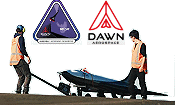 "A space domain awareness (SDA) payload
has flown on a sub-orbital spaceplane at supersonic speeds, an advance that could
provide an alternative to conventional satellite-based SDA. Scout Space's 'Morning
Sparrow' sensor suite flew aboard Dawn Aerospace's Aurora platform, an uncrewed
reusable rocket-powered high-altitude aircraft. The flight tested the integration
of Scout's 'Morning Sparrow' sensor suite aboard the Aurora platform, taking off
from Tāwhaki National Aerospace Centre in New Zealand. The flight also marks Scout
as the first commercial operator to fly on Dawn Aerospace's Aurora under a strategic
partnership in which Scout will develop a first-of-its-kind tactically responsive
Very Low Earth Orbit (VLEO)..." "A space domain awareness (SDA) payload
has flown on a sub-orbital spaceplane at supersonic speeds, an advance that could
provide an alternative to conventional satellite-based SDA. Scout Space's 'Morning
Sparrow' sensor suite flew aboard Dawn Aerospace's Aurora platform, an uncrewed
reusable rocket-powered high-altitude aircraft. The flight tested the integration
of Scout's 'Morning Sparrow' sensor suite aboard the Aurora platform, taking off
from Tāwhaki National Aerospace Centre in New Zealand. The flight also marks Scout
as the first commercial operator to fly on Dawn Aerospace's Aurora under a strategic
partnership in which Scout will develop a first-of-its-kind tactically responsive
Very Low Earth Orbit (VLEO)..."
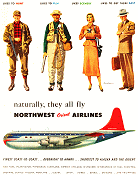 Northwest Orient Airlines, a prominent post-war
carrier, heavily promoted its transpacific and domestic routes in publications like
The Saturday Evening Post during the 1950s. Their advertisements, often
full-page and visually appealing, targeted a broad spectrum of potential travelers.
A common ad format featured a diverse group of Americans - hunters, fishermen, housewives,
and businessmen - representing the airline's wide appeal. This tableau of everyday
life was punctuated by a Northwest Orient Airlines aircraft, often a Boeing Stratocruiser
or Douglas DC-6, gracefully soaring across the page, connecting these disparate
figures and suggesting easy access to destinations both within the US and across
the Pacific. The ads emphasized comfort, speed, and the exotic allure of destinations
like Tokyo and Manila, solidifying Northwest Orient Airlines' image as a modern... Northwest Orient Airlines, a prominent post-war
carrier, heavily promoted its transpacific and domestic routes in publications like
The Saturday Evening Post during the 1950s. Their advertisements, often
full-page and visually appealing, targeted a broad spectrum of potential travelers.
A common ad format featured a diverse group of Americans - hunters, fishermen, housewives,
and businessmen - representing the airline's wide appeal. This tableau of everyday
life was punctuated by a Northwest Orient Airlines aircraft, often a Boeing Stratocruiser
or Douglas DC-6, gracefully soaring across the page, connecting these disparate
figures and suggesting easy access to destinations both within the US and across
the Pacific. The ads emphasized comfort, speed, and the exotic allure of destinations
like Tokyo and Manila, solidifying Northwest Orient Airlines' image as a modern...
|
The Airplanes and Rockets Homepage Archive
is a comprehensive collection of every item appearing daily on this website since
2017 - and many from earlier years.
 Cal Smith covers a huge amount of turf in
this article about the Academy of Model Aeronautics' (AMA's) control line
Navy Carrier event equipment, airframes, engines, and flying techniques.
Back in 1961, when this article appeared in American Modeler magazine,
the U.S. Navy was still sponsoring the AMA National Competition as a means of encouraging
young men to consider careers in the Navy as pilots as well as all the other disciplines
needed to keep the fleet afloat, so to speak. I always wanted to try building and
flying Carrier, but the opportunity never presented itself. There have not been
local clubs with a carrier deck, and I have neither the land area nor the money
to build my own. It sure seems like flying Carrier shouldn't be as difficult as
it really is, but I have watched competitions at Brodak and snagging one of the
arrestor lines ... Cal Smith covers a huge amount of turf in
this article about the Academy of Model Aeronautics' (AMA's) control line
Navy Carrier event equipment, airframes, engines, and flying techniques.
Back in 1961, when this article appeared in American Modeler magazine,
the U.S. Navy was still sponsoring the AMA National Competition as a means of encouraging
young men to consider careers in the Navy as pilots as well as all the other disciplines
needed to keep the fleet afloat, so to speak. I always wanted to try building and
flying Carrier, but the opportunity never presented itself. There have not been
local clubs with a carrier deck, and I have neither the land area nor the money
to build my own. It sure seems like flying Carrier shouldn't be as difficult as
it really is, but I have watched competitions at Brodak and snagging one of the
arrestor lines ...
 A long time ago, in a galaxy far, far away,
there existed a modeling civilization that enthusiastically embraced the concept
of building kits for the personal satisfaction of being able to hone craftsmanship
skills, to learn about the make-up of the products being built, and to save money.
Radio control systems were expensive on a per channel basis compared to today's
systems.
Heathkit, as it did with a very wide assortment of electronics
products, sold a few radio control systems in kit form. The buyer built everything
- transmitter, receiver, and servos. I do no remember whether the NiCd battery packs
came pre-assembled. Note that Heathkit servos used capacitive feedback ... A long time ago, in a galaxy far, far away,
there existed a modeling civilization that enthusiastically embraced the concept
of building kits for the personal satisfaction of being able to hone craftsmanship
skills, to learn about the make-up of the products being built, and to save money.
Radio control systems were expensive on a per channel basis compared to today's
systems.
Heathkit, as it did with a very wide assortment of electronics
products, sold a few radio control systems in kit form. The buyer built everything
- transmitter, receiver, and servos. I do no remember whether the NiCd battery packs
came pre-assembled. Note that Heathkit servos used capacitive feedback ...
 Leonardo da Vinci is usually credited with
producing the first illustration of a helicopter concept. It employed a rotating
helical corkscrew device at the top in order to enable the craft and occupant to
"screw his way aloft, in much the same manner as Archimedes designed his eponymous
helical screw device to lift water from a lower level to a higher level. Water,
being dense and cohesive with itself, was easily elevated, whilst air, not being
dense or cohesive, did not yield to the same technique. In fact, if the "aerial
screw" were able to spin rapidly enough and was of an efficient aerodynamic design,
it would work. Here is a 4-screw drone to prove it. These "Windmill
Planes" presented in the February 1939 issue of Popular Science magazine represent
the state of the art at the time. Surprisingly omitted is an example of Igor Sikorsky's
helicopter design, which he first flew successfully in September... Leonardo da Vinci is usually credited with
producing the first illustration of a helicopter concept. It employed a rotating
helical corkscrew device at the top in order to enable the craft and occupant to
"screw his way aloft, in much the same manner as Archimedes designed his eponymous
helical screw device to lift water from a lower level to a higher level. Water,
being dense and cohesive with itself, was easily elevated, whilst air, not being
dense or cohesive, did not yield to the same technique. In fact, if the "aerial
screw" were able to spin rapidly enough and was of an efficient aerodynamic design,
it would work. Here is a 4-screw drone to prove it. These "Windmill
Planes" presented in the February 1939 issue of Popular Science magazine represent
the state of the art at the time. Surprisingly omitted is an example of Igor Sikorsky's
helicopter design, which he first flew successfully in September...
 Genius takes on many forms, not the least
of which is the ability to concoct and compose an [almost] believable a story describing
in the utmost detail the technical workings of a complex mechanical gadget. Items
such as a mizule wrench, meta-phasic shielding, blinker fluid, a left-handed screwdriver,
and - one of my favorites - the muffler bearing, have been heard in comic routines...
er... routinely. No matter how many times you hear them you always laugh again.
Some are actually a portmanteau and just sound funny while others are completely
made up. This
Digital Decabulator article that appeared in a 1966 issue of
R/C Modeler magazine is amazing; it pegs the B.S. detector from beginning
to end ... Genius takes on many forms, not the least
of which is the ability to concoct and compose an [almost] believable a story describing
in the utmost detail the technical workings of a complex mechanical gadget. Items
such as a mizule wrench, meta-phasic shielding, blinker fluid, a left-handed screwdriver,
and - one of my favorites - the muffler bearing, have been heard in comic routines...
er... routinely. No matter how many times you hear them you always laugh again.
Some are actually a portmanteau and just sound funny while others are completely
made up. This
Digital Decabulator article that appeared in a 1966 issue of
R/C Modeler magazine is amazing; it pegs the B.S. detector from beginning
to end ...
 In this article appearing in the 1960 Annual
edition of Air Trails magazine, author Robert Angel introduces his "Uni−Flow"
concept for U-Control (aka control line, C/L) model airplanes. His method modifies
the standard wedge type metal fuel tank to operate on the same principle as an office
water cooler. By adding a strategically placed additional brass tubing vent, Mr. Angel
contends the pressure on the inside of the tank remains fairly constant as the vacuum
from the engine's carburetor draws fuel. This is preferred to pressurizing the fuel
tank via either a tap on the crankcase or off the muffler (which there were not
a lot of in 1960. Whether or not the Uni−Flow arrangement is any better than a standard
vent line or pressurization is still a matter of debate half a century later, as
can be seen in this StuntHanger.com forum thread. In fact, it seems the standard
C/L metal fuel tank is a form of uni−flow... In this article appearing in the 1960 Annual
edition of Air Trails magazine, author Robert Angel introduces his "Uni−Flow"
concept for U-Control (aka control line, C/L) model airplanes. His method modifies
the standard wedge type metal fuel tank to operate on the same principle as an office
water cooler. By adding a strategically placed additional brass tubing vent, Mr. Angel
contends the pressure on the inside of the tank remains fairly constant as the vacuum
from the engine's carburetor draws fuel. This is preferred to pressurizing the fuel
tank via either a tap on the crankcase or off the muffler (which there were not
a lot of in 1960. Whether or not the Uni−Flow arrangement is any better than a standard
vent line or pressurization is still a matter of debate half a century later, as
can be seen in this StuntHanger.com forum thread. In fact, it seems the standard
C/L metal fuel tank is a form of uni−flow...
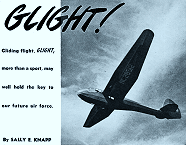 Gliders (aka sailplanes) have always attracted
me because of their
sleek
lines and graceful, silent flight. As a sailboat requires its pilot to possess
a knowledge of how to exploit properties of air currents to propel his water craft,
so, too, must a glider pilot know how to interpret and predict air currents to enable
long flights of his aircraft. As an enthusiast and practitioner of both model and
full-size boats and airplanes (many moons ago), I have great appreciation for both
motor-powered and nature-powered versions, but given a choice between the two, I'll
take the sailplane and the sailboat most of the time. It was not until materials
science was able to produce spars and skins strong and light enough for enabling
high aspect ratio wings that glider transformed from pudgy and boxy to lean and
highly aerodynamic. High performance sailplanes can achieve greater than 40:1 glide
ratios, meaning 40,000 feet (7½ miles) horizontally for every 1,000 feet of altitude
lost (in neutral air). In 1945 when this "Glight!" article appeared in Flying Age
magazine, the aforementioned materials discoveries had either not yet been made
or not yet applied to glider airframes, as can be seen in these photos... Gliders (aka sailplanes) have always attracted
me because of their
sleek
lines and graceful, silent flight. As a sailboat requires its pilot to possess
a knowledge of how to exploit properties of air currents to propel his water craft,
so, too, must a glider pilot know how to interpret and predict air currents to enable
long flights of his aircraft. As an enthusiast and practitioner of both model and
full-size boats and airplanes (many moons ago), I have great appreciation for both
motor-powered and nature-powered versions, but given a choice between the two, I'll
take the sailplane and the sailboat most of the time. It was not until materials
science was able to produce spars and skins strong and light enough for enabling
high aspect ratio wings that glider transformed from pudgy and boxy to lean and
highly aerodynamic. High performance sailplanes can achieve greater than 40:1 glide
ratios, meaning 40,000 feet (7½ miles) horizontally for every 1,000 feet of altitude
lost (in neutral air). In 1945 when this "Glight!" article appeared in Flying Age
magazine, the aforementioned materials discoveries had either not yet been made
or not yet applied to glider airframes, as can be seen in these photos...
 My very first radio control system was an
OS
Digital Digitron DS−3, 3−channel system. I have wanted to get one for nostalgia's
sake for a long time. I had a saved search on eBay for years and finally a few months
ago, one came up for auction, which I won. My plan is to replace the original 27.195 MHz
electronics with that of my 6−channel 72.750 MHz Futaba system, with necessary
modifications to the gimbal potentiometers, NiCad battery, antenna mount, etc. I
will need to add a dual rate switch somewhere inconspicuous so as to not detract
from the original look. The results will be posted here when done ... My very first radio control system was an
OS
Digital Digitron DS−3, 3−channel system. I have wanted to get one for nostalgia's
sake for a long time. I had a saved search on eBay for years and finally a few months
ago, one came up for auction, which I won. My plan is to replace the original 27.195 MHz
electronics with that of my 6−channel 72.750 MHz Futaba system, with necessary
modifications to the gimbal potentiometers, NiCad battery, antenna mount, etc. I
will need to add a dual rate switch somewhere inconspicuous so as to not detract
from the original look. The results will be posted here when done ...
 If you like cutting and gluing wing ribs,
this scale control line model of the
Curtiss P6−E Hawk
is the job for you. Let me know after doing these 92 ribs for two wings if you still
feel the same way. These plans and building article appeared in the November 1957
issue of American Modeler magazine. Designed for a .19 to .29 engine, this
31" wingspan model will certainly present a challenge even to the experienced modeler.
Of course you need to be able to apply and finish the covering with a high level
of perfection in order to fully appreciate the amount of work put into building
it. Personally, I would hate to have to use opaque paint for a scale color scheme
in order to not have to hide the framework. Then, I would be afraid to ever fly
it... If you like cutting and gluing wing ribs,
this scale control line model of the
Curtiss P6−E Hawk
is the job for you. Let me know after doing these 92 ribs for two wings if you still
feel the same way. These plans and building article appeared in the November 1957
issue of American Modeler magazine. Designed for a .19 to .29 engine, this
31" wingspan model will certainly present a challenge even to the experienced modeler.
Of course you need to be able to apply and finish the covering with a high level
of perfection in order to fully appreciate the amount of work put into building
it. Personally, I would hate to have to use opaque paint for a scale color scheme
in order to not have to hide the framework. Then, I would be afraid to ever fly
it...
 Some companies
have expressed an interest in being able to target Airplanes and Rockets via the
Google
AdSense program. Yes, it is possible to do that. As you might expect, finding
the exact information on the Google AdSense website is a bit difficult. This short
video does a good job summarizing exactly how to implement the "Ad Targeting" option,
then "Placements," and then add "Websites." Just enter airplanesandrockets.com
. There are other settings to optimize your advertising campaign with keywords (both
included and excluded), pricing, scheduling, statistical data collection and reporting,
etc. If you are currently using Google AdSense, then please consider this method,
and if you are not using AdSense, now would be a good time to look into it. I have
had reports from some companies that experience great results using AdSense (not
just on Airplanes and Rockets)... Some companies
have expressed an interest in being able to target Airplanes and Rockets via the
Google
AdSense program. Yes, it is possible to do that. As you might expect, finding
the exact information on the Google AdSense website is a bit difficult. This short
video does a good job summarizing exactly how to implement the "Ad Targeting" option,
then "Placements," and then add "Websites." Just enter airplanesandrockets.com
. There are other settings to optimize your advertising campaign with keywords (both
included and excluded), pricing, scheduling, statistical data collection and reporting,
etc. If you are currently using Google AdSense, then please consider this method,
and if you are not using AdSense, now would be a good time to look into it. I have
had reports from some companies that experience great results using AdSense (not
just on Airplanes and Rockets)...
 To the average Joe model builder who otherwise
has no shot at national recognition, having his model airplane featured in a magazine
like this 1939 issue of Flying Aces was a major source of pride. Even today
with easy access to making yourself known on the Internet, there is still something
special about seeing your self and/or your model appear in print. The Academy of
Model Aeronautics (AMAs) has each month a "Focal Point" section in its Model
Aviation magazine consisting of a collection of photos and descriptions of
models submitted by members. Most seem to be radio control, with an occasional control
line or free flight model. I even managed to have my scratch built 105% Aquila sailplane
in there a few years ago. As you can see in this "With
the Model Builders" page that there were no R/C models at all. The Good brothers
(Walt and Bill) were still in the early stages of developing reliable radio systems
at the time... To the average Joe model builder who otherwise
has no shot at national recognition, having his model airplane featured in a magazine
like this 1939 issue of Flying Aces was a major source of pride. Even today
with easy access to making yourself known on the Internet, there is still something
special about seeing your self and/or your model appear in print. The Academy of
Model Aeronautics (AMAs) has each month a "Focal Point" section in its Model
Aviation magazine consisting of a collection of photos and descriptions of
models submitted by members. Most seem to be radio control, with an occasional control
line or free flight model. I even managed to have my scratch built 105% Aquila sailplane
in there a few years ago. As you can see in this "With
the Model Builders" page that there were no R/C models at all. The Good brothers
(Walt and Bill) were still in the early stages of developing reliable radio systems
at the time...
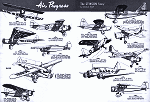 Most aviation enthusiasts, including moi,
think of the Reliant series of airplanes when the name Stinson is mentioned. Edward
"Eddie" Stinson was born in 1893 and at the time of his death due to an airplane
crash, he was the highest time pilot in the world with about 16,000 hours of logged
flight time. The Stinson Aircraft Company merged with Vultee Aircraft in 1932 and
was eventually bought out by the Piper Aircraft Corporation. Here is some interesting
trivia I discovered while researching this 1949 Air Trails magazine article: In
1943, Consolidated Aircraft and Vultee merged, creating Consolidated Vultee Aircraft
Corporation, popularly known as Convair. Convair (ConVAir) manufactured the F-106
Delta Dart, the B-36 Peacemaker bomber with six pusher propeller engines (and later
four jet engines), and also made that familiar XF Pogo vertical-takeoff-and-landing
(VTOL) airplane that had counter-rotating propellers and sat on its tail... Most aviation enthusiasts, including moi,
think of the Reliant series of airplanes when the name Stinson is mentioned. Edward
"Eddie" Stinson was born in 1893 and at the time of his death due to an airplane
crash, he was the highest time pilot in the world with about 16,000 hours of logged
flight time. The Stinson Aircraft Company merged with Vultee Aircraft in 1932 and
was eventually bought out by the Piper Aircraft Corporation. Here is some interesting
trivia I discovered while researching this 1949 Air Trails magazine article: In
1943, Consolidated Aircraft and Vultee merged, creating Consolidated Vultee Aircraft
Corporation, popularly known as Convair. Convair (ConVAir) manufactured the F-106
Delta Dart, the B-36 Peacemaker bomber with six pusher propeller engines (and later
four jet engines), and also made that familiar XF Pogo vertical-takeoff-and-landing
(VTOL) airplane that had counter-rotating propellers and sat on its tail...
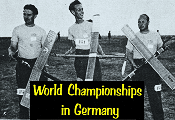 The 1956 Air Trails magazine Annual
Edition reported on the World Championships in Germany for the International Wakefield
Cup, F.A.I Free Flight, and Nordic A/2 Glider events. The three '55 World Championships
were held in September at the U.S. Air Force's Finthen Airfield, near Wiesbaden,
Germany. Competition was fierce amongst European and American contenders. It is
worthwhile to remember that 1955 was a mere eleven years after the end of World
War II, and that former foes were gathered together for a sporting contest.
There could easily have been men there who, without knowing it, were competing against
military adversaries they met on the battlefield or in occupied towns a decade earlier... The 1956 Air Trails magazine Annual
Edition reported on the World Championships in Germany for the International Wakefield
Cup, F.A.I Free Flight, and Nordic A/2 Glider events. The three '55 World Championships
were held in September at the U.S. Air Force's Finthen Airfield, near Wiesbaden,
Germany. Competition was fierce amongst European and American contenders. It is
worthwhile to remember that 1955 was a mere eleven years after the end of World
War II, and that former foes were gathered together for a sporting contest.
There could easily have been men there who, without knowing it, were competing against
military adversaries they met on the battlefield or in occupied towns a decade earlier...
 While not specifically drawn as plans for
building a model of the
Pietenpol
Air Camper, all the detail and dimensions necessary for scaling to any size
is possible using these sketches which appeared in the March 1961 issue of American
Modeler magazine. The "Piet" has been as popular a subject for modeling as is was
and still is for building full-size aircraft. Originally designed in 1930 by Bernard
Pietenpol, the craft borrowed many of its metal parts from Ford automobiles, including
the engine and suspension spring for a tail skid. Aircraft Spruce & Specialty
Company still sells Sitka spruce wood kits for the full-size Pietenpol Air Camper;
the total as of this writing is less than $4,000. You can be sure the information
contained in this article is trustworthy because it was authored by Mr. Pietenpol
himself! While not specifically drawn as plans for
building a model of the
Pietenpol
Air Camper, all the detail and dimensions necessary for scaling to any size
is possible using these sketches which appeared in the March 1961 issue of American
Modeler magazine. The "Piet" has been as popular a subject for modeling as is was
and still is for building full-size aircraft. Originally designed in 1930 by Bernard
Pietenpol, the craft borrowed many of its metal parts from Ford automobiles, including
the engine and suspension spring for a tail skid. Aircraft Spruce & Specialty
Company still sells Sitka spruce wood kits for the full-size Pietenpol Air Camper;
the total as of this writing is less than $4,000. You can be sure the information
contained in this article is trustworthy because it was authored by Mr. Pietenpol
himself!
 As a lifelong admirer of Charles Schulz's
Peanuts comic strip, I occasionally buy a collectible item like a Snoopy music box
that plays "It's a Long Way to Tipperary," a plastic Schroeder and piano figurine,
a Charlie Brown Skediddler, or a Snoopy astronaut from the Apollo era. This time
I bought the edition of TV Guide that announced the first showing of the "A Charlie Brown Christmas"
cartoon. Also in this edition is the announcement of plans to preempt regular programming
to televise the launch of the Gemini VII spacecraft, which carried astronauts
Frank Borman and James A. Lovell. It launched right on time at 7:30 pm on December
4th, 1965. "As his millions of fans long since have discovered, under that inept,
ineffectual, bumbling exterior of Charlie Brown's there beats a heart as soft and
sweet as a marshmallow. In the sequence on these pages, drawn exclusively for TV
Guide by Charlie's creator, Charles Schulz, he becomes concerned about the true
meaning of Christmas... As a lifelong admirer of Charles Schulz's
Peanuts comic strip, I occasionally buy a collectible item like a Snoopy music box
that plays "It's a Long Way to Tipperary," a plastic Schroeder and piano figurine,
a Charlie Brown Skediddler, or a Snoopy astronaut from the Apollo era. This time
I bought the edition of TV Guide that announced the first showing of the "A Charlie Brown Christmas"
cartoon. Also in this edition is the announcement of plans to preempt regular programming
to televise the launch of the Gemini VII spacecraft, which carried astronauts
Frank Borman and James A. Lovell. It launched right on time at 7:30 pm on December
4th, 1965. "As his millions of fans long since have discovered, under that inept,
ineffectual, bumbling exterior of Charlie Brown's there beats a heart as soft and
sweet as a marshmallow. In the sequence on these pages, drawn exclusively for TV
Guide by Charlie's creator, Charles Schulz, he becomes concerned about the true
meaning of Christmas...
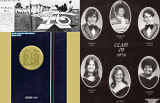 These images were scanned from my 1976 yearbook
for
Southern Senior High School in Harwood, Maryland. Only pages with information
on Seniors is included. Birthdates have been covered over, but everything else remains.
Please let me know if you would like your picture and/or information removed. On
the other hand, if you would like to send additional information for posting or
would like me to send you the full-resolution scan of your page, then please send
me an e-mail at KirtAAR@aol.com. A full list of all the names that go with these photos can be found at
the bottom of this page. Having them in text format (versus a photo) will allow
search engines to find your name and associate it with Southern Senior High School.
Oh, and yes, all the photos are in B&W; there are only eight pages with color
in the entire book! These images were scanned from my 1976 yearbook
for
Southern Senior High School in Harwood, Maryland. Only pages with information
on Seniors is included. Birthdates have been covered over, but everything else remains.
Please let me know if you would like your picture and/or information removed. On
the other hand, if you would like to send additional information for posting or
would like me to send you the full-resolution scan of your page, then please send
me an e-mail at KirtAAR@aol.com. A full list of all the names that go with these photos can be found at
the bottom of this page. Having them in text format (versus a photo) will allow
search engines to find your name and associate it with Southern Senior High School.
Oh, and yes, all the photos are in B&W; there are only eight pages with color
in the entire book!
 "Plane Views" was a monthly feature of
Flying Age magazine, with this installment being from the December 1945
issue. Flying Aces changed its name to Flying Age in the middle
of 1944, probably to focus on the rapidly advancing aeronautical technology prompted
by World War II. Whereas Flying Aces was full of fictional stories
of flying aces during World War I and the interim up though the middle of World
War II - along with plans for airplane models - Flying Age was essentially
an entirely new magazine with very little in the way of model aviation and none
of the adventure stories. Many Flying Aces readers were highly upset at
the extreme change, especially since it essentially abandoned the Flying Aces Club
as well. The Academy of Model Aeronautics (AMA) had no involvement with either the
Flying Aces or the Flying Age magazines. In fact, I don't recall
the AMA ever being mentioned. The AMA had its own magazine that went by various
titles over the years, including American Modeler, American Aircraft
Modeler, and its present incarnation, Model Aviation... "Plane Views" was a monthly feature of
Flying Age magazine, with this installment being from the December 1945
issue. Flying Aces changed its name to Flying Age in the middle
of 1944, probably to focus on the rapidly advancing aeronautical technology prompted
by World War II. Whereas Flying Aces was full of fictional stories
of flying aces during World War I and the interim up though the middle of World
War II - along with plans for airplane models - Flying Age was essentially
an entirely new magazine with very little in the way of model aviation and none
of the adventure stories. Many Flying Aces readers were highly upset at
the extreme change, especially since it essentially abandoned the Flying Aces Club
as well. The Academy of Model Aeronautics (AMA) had no involvement with either the
Flying Aces or the Flying Age magazines. In fact, I don't recall
the AMA ever being mentioned. The AMA had its own magazine that went by various
titles over the years, including American Modeler, American Aircraft
Modeler, and its present incarnation, Model Aviation...
 SpaceX
and Blue Origin have been in the news for the last decade for their efforts (some
successful, some not) to
autonomously land a spacecraft vertically under its own power. Love it or hate
it, NASA has been doing that for nearly six decades. Granted, it was on celestial
bodies with lower gravitational acceleration than on Earth, but the earliest craft
(Surveyor 1, 1966) had relatively crude electronics aboard, including a Doppler
radar, flight computer, and video camera. The now legendary Apollo Guidance Computer
has been written about extensively, and is a testimony to the brilliance of the
scientists, engineers, managers, operators, and technicians who built and flew it.
Articles like this one in the May 1967 issue of Radio-Electronics magazine... SpaceX
and Blue Origin have been in the news for the last decade for their efforts (some
successful, some not) to
autonomously land a spacecraft vertically under its own power. Love it or hate
it, NASA has been doing that for nearly six decades. Granted, it was on celestial
bodies with lower gravitational acceleration than on Earth, but the earliest craft
(Surveyor 1, 1966) had relatively crude electronics aboard, including a Doppler
radar, flight computer, and video camera. The now legendary Apollo Guidance Computer
has been written about extensively, and is a testimony to the brilliance of the
scientists, engineers, managers, operators, and technicians who built and flew it.
Articles like this one in the May 1967 issue of Radio-Electronics magazine...
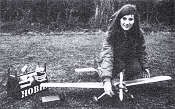 Danny M., a website visitor from The
Land Down Under, wrote to ask that I scan and post this article for what today we
would call a "smart" glow plug driver. There is also an accompanying article in
the same July 1974 edition of American Aircraft Modeler magazine titled "The AAM
Glowdriver." Danny said, "I built one in 1978, it is still working fine. When a
friend saw how it would light a plug under water and clear a flooded engine instantly
he begged me to build him one. Unfortunately the original article is long gone,
so I found your website and noticed that you list the magazine in question." Well,
thanks to our resourceful mate, now the plans and article are available again in
case you are experiencing a bit of nostalgia... Danny M., a website visitor from The
Land Down Under, wrote to ask that I scan and post this article for what today we
would call a "smart" glow plug driver. There is also an accompanying article in
the same July 1974 edition of American Aircraft Modeler magazine titled "The AAM
Glowdriver." Danny said, "I built one in 1978, it is still working fine. When a
friend saw how it would light a plug under water and clear a flooded engine instantly
he begged me to build him one. Unfortunately the original article is long gone,
so I found your website and noticed that you list the magazine in question." Well,
thanks to our resourceful mate, now the plans and article are available again in
case you are experiencing a bit of nostalgia... |



